Artificial Neural Networks to Retrieve Land and Sea Skin Temperature from IASI
Abstract
1. Introduction
2. Data and Methods
2.1. Choice of IASI Spectral Window for Tskin Retrieval
2.2. Channel Selection based on Entropy Reduction
2.3. Artificial Neural Network for Tskin Retrievals
2.3.1. Tskin Retrievals over Sea
2.3.2. Skin Temperature Retrievals over Land
2.4. Datasets Used for Validation
2.4.1. EUMETSAT Tskin Product
2.4.2. ERA5 Tskin Product
2.4.3. SEVIRI Tskin Product
2.4.4. Ground Observations
3. Results
3.1. Validation of TANN with ERA5, EUMETSAT and SEVIRI Tskin Products
3.2. Validation of the TANN with Ground-Based Measurements
3.2.1. Validation at the Gobabeb Site
3.2.2. Validation at the SURFRAD Station
4. Discussion and Conclusions
Author Contributions
Funding
Acknowledgments
Conflicts of Interest
References
- Goldberg, M.D.; Qu, Y.; McMillin, L.M.; Wolf, W.; Zhou, L.; Divakarla, M. AIRS near-real-time products and algorithms in support of operational numerical weather prediction. IEEE Trans. Geosci. Remote Sens. 2003, 41, 379–389. [Google Scholar] [CrossRef]
- Zhou, L.; Dickinson, R.E.; Tian, Y.; Jin, M.; Ogawa, K.; Yu, H.; Schmugge, T. A sensitivity study of climate and energy balance simulations with use of satellite-derived emissivity data over Northern Africa and the Arabian Peninsula. J. Geophys. Res. Atmos. 2003, 108, 4795. [Google Scholar] [CrossRef]
- Rhee, J.; Im, J.; Carbone, G.J. Monitoring agricultural drought for arid and humid regions using multi-sensor remote sensing data. Remote Sens. Environ. 2010, 114, 2875–2887. [Google Scholar] [CrossRef]
- Becker, F.; Li, Z. Surface temperature and emissivity at various scales: Definition, measurement and related problems. Remote Sens. Rev. 1995, 12, 225–253. [Google Scholar] [CrossRef]
- McKeown, W.; Bretherton, F.; Huang, H.L.; Smith, W.L.; Revercomb, H.L. Sounding the Skin of Water: Sensing Air–Water Interface Temperature Gradients with Interferometry. J. Atmos. Ocean. Technol. 1995, 12, 1313–1327. [Google Scholar] [CrossRef]
- Prigent, C.; Aires, F.; Rossow, W.B. Land surface skin temperatures from a combined analysis of microwave and infrared satellite observations for an all-weather evaluation of the differences between air and skin temperatures. J. Geophys. Res. Atmos. 2003, 108, 4310. [Google Scholar] [CrossRef]
- Prigent, C.; Aires, F.; Rossow, W.B. Retrieval of Surface and Atmospheric Geophysical Variables over Snow-Covered Land from Combined Microwave and Infrared Satellite Observations. J. Appl. Meteorol. 2003, 42, 368–380. [Google Scholar] [CrossRef]
- Good, E.J. An in situ-based analysis of the relationship between land surface “skin” and screen-level air temperatures. J. Geophys. Res. Atmos. 2016, 121, 8801–8819. [Google Scholar] [CrossRef]
- Trigo, I.F.; Peres, L.F.; DaCamara, C.C.; Freitas, S.C. Thermal Land Surface Emissivity Retrieved From SEVIRI/Meteosat. IEEE Trans. Geosci. Remote Sens. 2008, 46, 307–315. [Google Scholar] [CrossRef]
- Jin, M. Analysis of Land Skin Temperature Using AVHRR Observations. Bull. Am. Meteorol. Soc. 2004, 85, 587–600. [Google Scholar] [CrossRef]
- Wan, Z.; Li, Z. A physics-based algorithm for retrieving land-surface emissivity and temperature from EOS/MODIS data. IEEE Trans. Geosci. Remote Sens. 1997, 35, 980–996. [Google Scholar] [CrossRef]
- Ruzmaikin, A.; Aumann, H.H.; Lee, J.; Susskind, J. Diurnal Cycle Variability of Surface Temperature Inferred From AIRS Data. J. Geophys. Res. Atmos. 2017, 122, 10928–10938. [Google Scholar] [CrossRef]
- Siméoni, D.; Singer, C.; Chalon, G. Infrared atmospheric sounding interferometer. Acta Astronaut. 1997, 40, 113–118. [Google Scholar] [CrossRef]
- Blumstein, D.; Chalon, G.; Carlier, T.; Buil, C.; Hebert, P.; Maciaszek, T.; Ponce, G.; Phulpin, T.; Tournier, B.; Simeoni, D.; et al. IASI Instrument: Technical Overview and Measured Performances. In Infrared Spaceborne Remote Sensing XII; International Society for Optics and Photonics: Washington, DC, USA, 2004; Volume 5543, pp. 196–207. [Google Scholar]
- Hilton, F.; Armante, R.; August, T.; Barnet, C.; Bouchard, A.; Camy-Peyret, C.; Capelle, V.; Clarisse, L.; Clerbaux, C.; Coheur, P.-F.; et al. Hyperspectral Earth Observation from IASI: Five Years of Accomplishments. Bull. Am. Meteorol. Soc. 2012, 93, 347–370. [Google Scholar] [CrossRef]
- Collard, A.D.; McNally, A.P. The assimilation of Infrared Atmospheric Sounding Interferometer radiances at ECMWF. Q. J. R. Meteorol. Soc. 2009, 135, 1044–1058. [Google Scholar] [CrossRef]
- Clerbaux, C.; Boynard, A.; Clarisse, L.; George, M.; Hadji-Lazaro, J.; Herbin, H.; Hurtmans, D.; Pommier, M.; Razavi, A.; Turquety, S.; et al. Monitoring of atmospheric composition using the thermal infrared IASI/MetOp sounder. Atmos. Chem. Phys. 2009, 9, 6041–6054. [Google Scholar] [CrossRef]
- Coheur, P.-F.; Clarisse, L.; Turquety, S.; Hurtmans, D.; Clerbaux, C. IASI measurements of reactive trace species in biomass burning plumes. Atmos. Chem. Phys. 2009, 9, 5655–5667. [Google Scholar] [CrossRef]
- Clarisse, L.; R’Honi, Y.; Coheur, P.-F.; Hurtmans, D.; Clerbaux, C. Thermal infrared nadir observations of 24 atmospheric gases. Geophys. Res. Lett. 2011, 38, L10802. [Google Scholar] [CrossRef]
- Clerbaux, C.; Hadji-Lazaro, J.; Turquety, S.; George, M.; Boynard, A.; Pommier, M.; Safieddine, S.; Coheur, P.-F.; Hurtmans, D.; Clarisse, L.; et al. Tracking pollutants from space: Eight years of IASI satellite observation. C. R. Geosci. 2015, 347, 134–144. [Google Scholar] [CrossRef]
- Clerbaux, C.; Hadji-Lazaro, J.; Turquety, S.; Mégie, G.; Coheur, P.-F. Trace gas measurements from infrared satellite for chemistry and climate applications. Atmos. Chem. Phys. 2003, 3, 1495–1508. [Google Scholar] [CrossRef]
- Brindley, H.; Bantges, R.; Russell, J.; Murray, J.; Dancel, C.; Belotti, C.; Harries, J. Spectral Signatures of Earth’s Climate Variability over 5 Years from IASI. J. Clim. 2015, 28, 1649–1660. [Google Scholar] [CrossRef]
- Smith, N.; Smith, W.L.; Weisz, E.; Revercomb, H.E. AIRS, IASI, and CrIS Retrieval Records at Climate Scales: An Investigation into the Propagation of Systematic Uncertainty. J. Appl. Meteorol. Clim. 2015, 54, 1465–1481. [Google Scholar] [CrossRef]
- Whitburn, S.; Clarisse, L.; Bauduin, S.; George, M.; Hurtmans, D.; Safieddine, S.; Coheur, P.F.; Clerbaux, C. Spectrally Resolved Fluxes from IASI Data: Retrieval Algorithm for Clear-Sky Measurements. J. Clim. 2020, 33, 6971–6988. [Google Scholar] [CrossRef]
- Zhou, D.K.; Larar, A.M.; Liu, X. Global Surface Skin Temperature Analysis from Recent Decadal IASI Observations. In Multispectral, Hyperspectral, and Ultraspectral Remote Sensing Technology, Techniques and Applications VII; International Society for Optics and Photonics: Washington, DC, USA, 2018; Volume 10780, p. 1078005. [Google Scholar]
- Brindley, H.E.; Bantges, R.J. The Spectral Signature of Recent Climate Change. Curr. Clim. Chang. Rep. 2016, 2, 112–126. [Google Scholar] [CrossRef]
- Susskind, J.; Schmidt, G.A.; Lee, J.N.; Iredell, L. Recent global warming as confirmed by AIRS. Environ. Res. Lett. 2019, 14, 044030. [Google Scholar] [CrossRef]
- CLERBAUX, C.; CREVOISIER, C. New Directions: Infrared remote sensing of the troposphere from satellite: Less, but better. Atmos. Environ. 2013, 72, 24–26. [Google Scholar] [CrossRef]
- Crevoisier, C.; Clerbaux, C.; Guidard, V.; Phulpin, T.; Armante, R.; Barret, B.; Camy-Peyret, C.; Chaboureau, J.-P.; Coheur, P.-F.; Crépeau, L.; et al. Towards IASI-New Generation (IASI-NG): Impact of improved spectral resolution and radiometric noise on the retrieval of thermodynamic, chemistry and climate variables. Atmos. Meas. Tech. 2014, 7, 4367–4385. [Google Scholar] [CrossRef]
- Klaes, K.D.; Cohen, M.; Buhler, Y.; Schlüssel, P.; Munro, R.; Luntama, J.-P.; von Engeln, A.; Clérigh, E.Ó.; Bonekamp, H.; Ackermann, J.; et al. An Introduction to the EUMETSAT Polar system. Bull. Am. Meteorol. Soc. 2007, 88, 1085–1096. [Google Scholar] [CrossRef]
- EUMETSAT IASI Level 1: Product Guide; EUM/OPS-EPS/MAN/04/0032 2017; EUMETSAT: Darmstadt, Germany, 2017.
- EUMETSAT IASI Level 2: Product Guide; EUM/OPS-EPS/MAN/04/0033 2017; EUMETSAT: Darmstadt, Germany, 2017.
- EUMETSAT IASxxx1C0100IASI Level 1C Climate Data Record Release 1-Metop-A; EUMETSAT: Darmstadt, Germany, 2018. [CrossRef]
- Rodgers, C.D. Information content and optimisation of high spectral resolution remote measurements. Adv. Space Res. 1998, 21, 361–367. [Google Scholar] [CrossRef]
- Collard, A.D. Selection of IASI channels for use in numerical weather prediction. Q. J. R. Meteorol. Soc. 2007, 133, 1977–1991. [Google Scholar] [CrossRef]
- Saunders, R.; Hocking, J.; Turner, E.; Rayer, P.; Rundle, D.; Brunel, P.; Vidot, J.; Roquet, P.; Matricardi, M.; Geer, A.; et al. An update on the RTTOV fast radiative transfer model (currently at version 12). Geosci. Model Dev. 2018, 11, 2717–2737. [Google Scholar] [CrossRef]
- Rodgers, C.D. Inverse Methods for Atmospheric Sounding; Series on Atmospheric, Oceanic and Planetary Physics; World Scientific: Singapore, 2000; Volume 2, ISBN 978-981-02-2740-1. [Google Scholar]
- Rabier, F.; Fourrié, N.; Chafäi, D.; Prunet, P. Channel selection methods for Infrared Atmospheric Sounding Interferometer radiances. Q. J. R. Meteorol. Soc. 2002, 128, 1011–1027. [Google Scholar] [CrossRef]
- Contreras-Reyes, J.E. Asymptotic form of the Kullback–Leibler divergence for multivariate asymmetric heavy-tailed distributions. Phys. A Stat. Mech. Appl. 2014, 395, 200–208. [Google Scholar] [CrossRef]
- Aires, F.; Pellet, V.; Prigent, C.; Moncet, J.-L. Dimension reduction of satellite observations for remote sensing. Part 1: A comparison of compression, channel selection and bottleneck channel approaches. Q. J. R. Meteorol. Soc. 2016, 142, 2658–2669. [Google Scholar] [CrossRef]
- Pellet, V.; Aires, F. Dimension reduction of satellite observations for remote sensing. Part 2: Illustration using hyperspectral microwave observations. Q. J. R. Meteorol. Soc. 2016, 142, 2670–2678. [Google Scholar] [CrossRef]
- Ventress, L.; Dudhia, A. Improving the selection of IASI channels for use in numerical weather prediction. Q. J. R. Meteorol. Soc. 2014, 140, 2111–2118. [Google Scholar] [CrossRef]
- Moncet, J.-L.; Uymin, G.; Lipton, A.E.; Snell, H.E. Infrared Radiance Modeling by Optimal Spectral Sampling. J. Atmos. Sci. 2008, 65, 3917–3934. [Google Scholar] [CrossRef]
- Chevallier, F.; Chéruy, F.; Scott, N.A.; Chédin, A. A Neural Network Approach for a Fast and Accurate Computation of a Longwave Radiative Budget. J. Appl. Meteorol. 1998, 37, 1385–1397. [Google Scholar] [CrossRef]
- Pellet, V.; Aires, F. Bottleneck Channels Algorithm for Satellite Data Dimension Reduction: A Case Study for IASI. IEEE Trans. Geosci. Remote Sens. 2018, 56, 6069–6081. [Google Scholar] [CrossRef]
- Aires, F.; Chédin, A.; Scott, N.A.; Rossow, W.B. A Regularized Neural Net Approach for Retrieval of Atmospheric and Surface Temperatures with the IASI Instrument. J. Appl. Meteorol. 2002, 41, 144–159. [Google Scholar] [CrossRef]
- Blackwell, W.J.; Chen, F.W. Neural Networks in Atmospheric Remote Sensing; Artech House: Norwood, MA, USA, 2009; ISBN 978-1-59693-373-6. [Google Scholar]
- Hadji-Lazaro, J.; Clerbaux, C.; Thiria, S. An inversion algorithm using neural networks to retrieve atmospheric CO total columns from high-resolution nadir radiances. J. Geophys. Res. Atmos. 1999, 104, 23841–23854. [Google Scholar] [CrossRef]
- Whitburn, S.; Damme, M.V.; Clarisse, L.; Bauduin, S.; Heald, C.L.; Hadji-Lazaro, J.; Hurtmans, D.; Zondlo, M.A.; Clerbaux, C.; Coheur, P.-F. A flexible and robust neural network IASI-NH3 retrieval algorithm. J. Geophys. Res. Atmos. 2016, 121, 6581–6599. [Google Scholar] [CrossRef]
- Damme, M.V.; Whitburn, S.; Clarisse, L.; Clerbaux, C.; Hurtmans, D.; Coheur, P.-F. Version 2 of the IASI NH3 neural network retrieval algorithm: Near-real-time and reanalysed datasets. Atmos. Meas. Tech. 2017, 10, 4905–4914. [Google Scholar] [CrossRef]
- Aires, F.; Prigent, C.; Rossow, W.B. Sensitivity of satellite microwave and infrared observations to soil moisture at a global scale: 2. Global statistical relationships. J. Geophys. Res. Atmos. 2005, 110. [Google Scholar] [CrossRef]
- Kolassa, J.; Aires, F.; Polcher, J.; Prigent, C.; Jimenez, C.; Pereira, J.M. Soil moisture retrieval from multi-instrument observations: Information content analysis and retrieval methodology. J. Geophys. Res. Atmos. 2013, 118, 4847–4859. [Google Scholar] [CrossRef]
- Rodriguez-Fernandez, N.; Richaume, P.; Aires, F.; Prigent, C.; Kerr, Y.; Kolassa, J.; Jimenez, C.; Cabot, F.; Mahmoodi, A. Soil moisture retrieval from SMOS observations using neural networks. In Proceedings of the 2014 IEEE Geoscience and Remote Sensing Symposium, Quebec, QC, Canada, 13–18 July 2014; pp. 2431–2434. [Google Scholar]
- Milstein, A.B.; Blackwell, W.J. Neural network temperature and moisture retrieval algorithm validation for AIRS/AMSU and CrIS/ATMS. J. Geophys. Res. Atmos. 2016, 121, 1414–1430. [Google Scholar] [CrossRef]
- Tao, Z.; Blackwell, W.J.; Staelin, D.H. Error Variance Estimation for Individual Geophysical Parameter Retrievals. IEEE Trans. Geosci. Remote Sens. 2013, 51, 1718–1727. [Google Scholar] [CrossRef]
- Hersbach, H.; Bell, B.; Berrisford, P.; Hirahara, S.; Horányi, A.; Muñoz-Sabater, J.; Nicolas, J.; Peubey, C.; Radu, R.; Schepers, D.; et al. The ERA5 global reanalysis. Q. J. R. Meteorol. Soc. 2020, 146, 1999–2049. [Google Scholar] [CrossRef]
- Thepaut, J.-N.; Pinty, B.; Dee, D. The Copernicus Programme and its Climate Change Service (C3S): A European Response to Climate Change. COSPAR Sci. Assem. 2018, 42, 1591–1593. [Google Scholar]
- Maddy, E.S.; King, T.S.; Sun, H.; Wolf, W.W.; Barnet, C.D.; Heidinger, A.; Cheng, Z.; Goldberg, M.D.; Gambacorta, A.; Zhang, C.; et al. Using MetOp-A AVHRR Clear-Sky Measurements to Cloud-Clear MetOp-A IASI Column Radiances. J. Atmos. Ocean. Technol. 2011, 28, 1104–1116. [Google Scholar] [CrossRef]
- Tetzner, D.; Thomas, E.; Allen, C. A Validation of ERA5 Reanalysis Data in the Southern Antarctic Peninsula—Ellsworth Land Region, and Its Implications for Ice Core Studies. Geosciences 2019, 9, 289. [Google Scholar] [CrossRef]
- Zhou, D.K.; Larar, A.M.; Liu, X.; Smith, W.L.; Strow, L.L.; Yang, P.; Schlüssel, P.; Calbet, X. Global Land Surface Emissivity Retrieved From Satellite Ultraspectral IR Measurements. IEEE Trans. Geosci. Remote Sens. 2011, 49, 1277–1290. [Google Scholar] [CrossRef]
- Zhou, D.K.; Larar, A.M.; Liu, X. MetOp-A/IASI Observed Continental Thermal IR Emissivity Variations. IEEE J. Sel. Top. Appl. Earth Obs. Remote Sens. 2013, 6, 1156–1162. [Google Scholar] [CrossRef]
- August, T.; Klaes, D.; Schlüssel, P.; Hultberg, T.; Crapeau, M.; Arriaga, A.; O’Carroll, A.; Coppens, D.; Munro, R.; Calbet, X. IASI on Metop-A: Operational Level 2 retrievals after five years in orbit. J. Quant. Spectrosc. Radiat. Transf. 2012, 113, 1340–1371. [Google Scholar] [CrossRef]
- EUMETSAT IASI L2 Metop-B Validation Report; EUM/TSS/REP/13/684650 2013; EUMETSAT: Darmstadt, Germany, 2013.
- ECMWF IFS DOCUMENTATION—Cy43r1 Operational Implementation Part IV: Physical Processes; ECMWF: Reading, UK, 2016.
- McLaren, A.; Fiedler, E.; Roberts-Jones, J.; Martin, M.; Mao, C.; Good, S. Quality Information Document Global Ocean OSTIA near Real Time Level 4 Sea Surface Temperature Product; SST-GLO-SST-L4-NRT-OBSERVATIONS-010-001, EU Copernicus Marine Service. 2016. Available online: https://resources.marine.copernicus.eu/documents/QUID/CMEMS-OSI-QUID-010-001.pdf (accessed on 24 August 2020).
- Hirahara, S.; Alonso-Balmaseda, M.; de Boisseson, E.; Hersbach, H. Sea Surface Temperature and Sea Ice Concentration for ERA5. Available online: https://www.ecmwf.int/en/elibrary/16555-sea-surface-temperature-and-sea-ice-concentration-era5 (accessed on 8 April 2020).
- Schmetz, J.; Pili, P.; Tjemkes, S.; Just, D.; Kerkmann, J.; Rota, S.; Ratier, A. An introduction to meteosat second generation (MSG). Bull. Am. Meteorol. Soc. 2002, 83, 977–992. [Google Scholar] [CrossRef]
- Trigo, I.F.; Dacamara, C.C.; Viterbo, P.; Roujean, J.-L.; Olesen, F.; Barroso, C.; Camacho-de-Coca, F.; Carrer, D.; Freitas, S.C.; García-Haro, J.; et al. Satellite Application Facility for Land Surface Analysis. Int. J. Remote Sens. 2011, 32, 2725–2744. [Google Scholar] [CrossRef]
- Freitas, S.C.; Trigo, I.F.; Bioucas-Dias, J.M.; Gottsche, F.-M. Quantifying the Uncertainty of Land Surface Temperature Retrievals from SEVIRI/Meteosat. IEEE Trans. Geosci. Remote Sens. 2010, 48, 523–534. [Google Scholar] [CrossRef]
- Martin, M.A.; Ghent, D.; Pires, A.C.; Göttsche, F.-M.; Cermak, J.; Remedios, J.J. Comprehensive In Situ Validation of Five Satellite Land Surface Temperature Data Sets over Multiple Stations and Years. Remote Sens. 2019, 11, 479. [Google Scholar] [CrossRef]
- Göttsche, F.-M.; Olesen, F.-S.; Trigo, I.F.; Bork-Unkelbach, A.; Martin, M.A. Long Term Validation of Land Surface Temperature Retrieved from MSG/SEVIRI with Continuous in-Situ Measurements in Africa. Remote Sens. 2016, 8, 410. [Google Scholar] [CrossRef]
- Göttsche, F.-M.; Hulley, G.C. Validation of six satellite-retrieved land surface emissivity products over two land cover types in a hyper-arid region. Remote Sens. Environ. 2012, 124, 149–158. [Google Scholar] [CrossRef]
- Göttsche, F.-M.; Olesen, F.-S.; Bork-Unkelbach, A. Validation of land surface temperature derived from MSG/SEVIRI with in situ measurements at Gobabeb, Namibia. Int. J. Remote Sens. 2013, 34, 3069–3083. [Google Scholar] [CrossRef]
- Göttsche, F.-M.; Olesen, F.S.; Poutier, L.; Langlois, S.; Wimmer, W.; Santos, V.G.; Coll, C.; Niclos, R.; Arbelo, M.; Monchau, J.-P. Report from the Field Inter-Comparison Experiment (FICE) for Land Surface Temperature; Technical Report. ESA. 2017. Available online: http://www.frm4sts.org/wp-content/uploads/sites/3/2018/10/FRM4STS_LST-FICE_report_v2017-11-20_signed.pdf (accessed on 24 August 2020).
- Guillevic, P.C.; Bork-Unkelbach, A.; Göttsche, F.M.; Hulley, G.; Gastellu-Etchegorry, J.-P.; Olesen, F.S.; Privette, J.L. Directional Viewing Effects on Satellite Land Surface Temperature Products Over Sparse Vegetation Canopies—A Multisensor Analysis. IEEE Geosci. Remote Sens. Lett. 2013, 10, 1464–1468. [Google Scholar] [CrossRef]
- Ermida, S.L.; Trigo, I.F.; DaCamara, C.C.; Göttsche, F.M.; Olesen, F.S.; Hulley, G. Validation of remotely sensed surface temperature over an oak woodland landscape—The problem of viewing and illumination geometries. Remote Sens. Environ. 2014, 148, 16–27. [Google Scholar] [CrossRef]
- Augustine, J.A.; Deluisi, J.J.; Long, C.N. SURFRAD—A National Surface Radiation Budget Network for Atmospheric Research. Bull. Am. Meteorol. Soc. 2000, 81, 2341–2358. [Google Scholar] [CrossRef]
- Augustine, J.A.; Hodges, G.B.; Cornwall, C.R.; Michalsky, J.J.; Medina, C.I. An Update on SURFRAD—The GCOS Surface Radiation Budget Network for the Continental United States. J. Atmos. Ocean. Technol. 2005, 22, 1460–1472. [Google Scholar] [CrossRef]
- Heidinger, A.K.; Laszlo, I.; Molling, C.C.; Tarpley, D. Using SURFRAD to Verify the NOAA Single-Channel Land Surface Temperature Algorithm. J. Atmos. Ocean. Technol. 2013, 30, 2868–2884. [Google Scholar] [CrossRef]
- Guillevic, P.C.; Privette, J.L.; Coudert, B.; Palecki, M.A.; Demarty, J.; Ottlé, C.; Augustine, J.A. Land Surface Temperature product validation using NOAA’s surface climate observation networks—Scaling methodology for the Visible Infrared Imager Radiometer Suite (VIIRS). Remote Sens. Environ. 2012, 124, 282–298. [Google Scholar] [CrossRef]
- Wang, W.; Liang, S.; Meyers, T. Validating MODIS land surface temperature products using long-term nighttime ground measurements. Remote Sens. Environ. 2008, 112, 623–635. [Google Scholar] [CrossRef]
- Wang, K.; Liang, S. Evaluation of ASTER and MODIS land surface temperature and emissivity products using long-term surface longwave radiation observations at SURFRAD sites. Remote Sens. Environ. 2009, 113, 1556–1565. [Google Scholar] [CrossRef]
- Guillevic, P.C.; Biard, J.C.; Hulley, G.C.; Privette, J.L.; Hook, S.J.; Olioso, A.; Göttsche, F.M.; Radocinski, R.; Román, M.O.; Yu, Y.; et al. Validation of Land Surface Temperature products derived from the Visible Infrared Imaging Radiometer Suite (VIIRS) using ground-based and heritage satellite measurements. Remote Sens. Environ. 2014, 154, 19–37. [Google Scholar] [CrossRef]
- Bouillon, M.; Safieddine, S.; Hadji-Lazaro, J.; Whitburn, S.; Clarisse, L.; Doutriaux-Boucher, M.; Coppens, D.; August, T.; Jacquette, E.; Clerbaux, C. Ten-Year Assessment of IASI Radiance and Temperature. Remote Sens. 2020, 12, 2393. [Google Scholar] [CrossRef]
- Trigo, I.F.; Boussetta, S.; Viterbo, P.; Balsamo, G.; Beljaars, A.; Sandu, I. Comparison of model land skin temperature with remotely sensed estimates and assessment of surface-atmosphere coupling. J. Geophys. Res. Atmos. 2015, 120, 12096–12111. [Google Scholar] [CrossRef]
- Garand, L. Toward an Integrated Land–Ocean Surface Skin Temperature Analysis from the Variational Assimilation of Infrared Radiances. J. Appl. Meteorol. 2003, 42, 570–583. [Google Scholar] [CrossRef]
- Zheng, W.; Wei, H.; Wang, Z.; Zeng, X.; Meng, J.; Ek, M.; Mitchell, K.; Derber, J. Improvement of daytime land surface skin temperature over arid regions in the NCEP GFS model and its impact on satellite data assimilation. J. Geophys. Res. Atmos. 2012, 117, D06117. [Google Scholar] [CrossRef]
- Trigo, I.F.; Viterbo, P. Clear-Sky Window Channel Radiances: A Comparison between Observations and the ECMWF Model. J. Appl. Meteorol. 2003, 42, 1463–1479. [Google Scholar] [CrossRef]
- Pearson, R.K. Outliers in process modeling and identification. Ieee Trans. Control Syst. Technol. 2002, 10, 55–63. [Google Scholar] [CrossRef]
- Yang, J.; Zhou, J.; Göttsche, F.-M.; Long, Z.; Ma, J.; Luo, R. Investigation and validation of algorithms for estimating land surface temperature from Sentinel-3 SLSTR data. Int. J. Appl. Earth Obs. Geoinf. 2020, 91, 102136. [Google Scholar] [CrossRef]
- Paul, M.; Aires, F.; Prigent, C.; Trigo, I.F.; Bernardo, F. An innovative physical scheme to retrieve simultaneously surface temperature and emissivities using high spectral infrared observations from IASI. J. Geophys. Res. Atmos. 2012, 117, D11302. [Google Scholar] [CrossRef]
- Prata, A.J.; Caselles, V.; Coll, C.; Sobrino, J.A.; Ottlé, C. Thermal remote sensing of land surface temperature from satellites: Current status and future prospects. Remote Sens. Rev. 1995, 12, 175–224. [Google Scholar] [CrossRef]
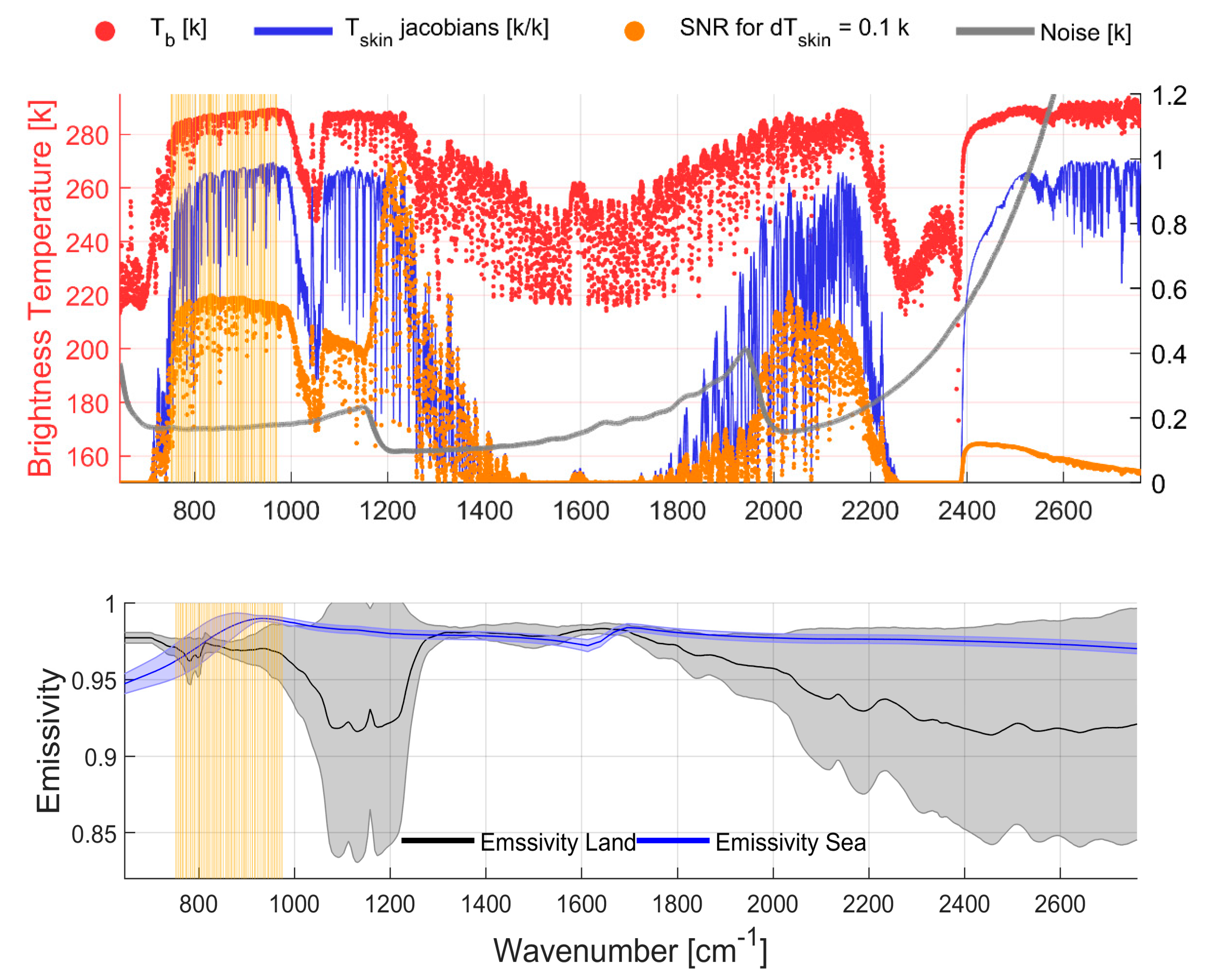
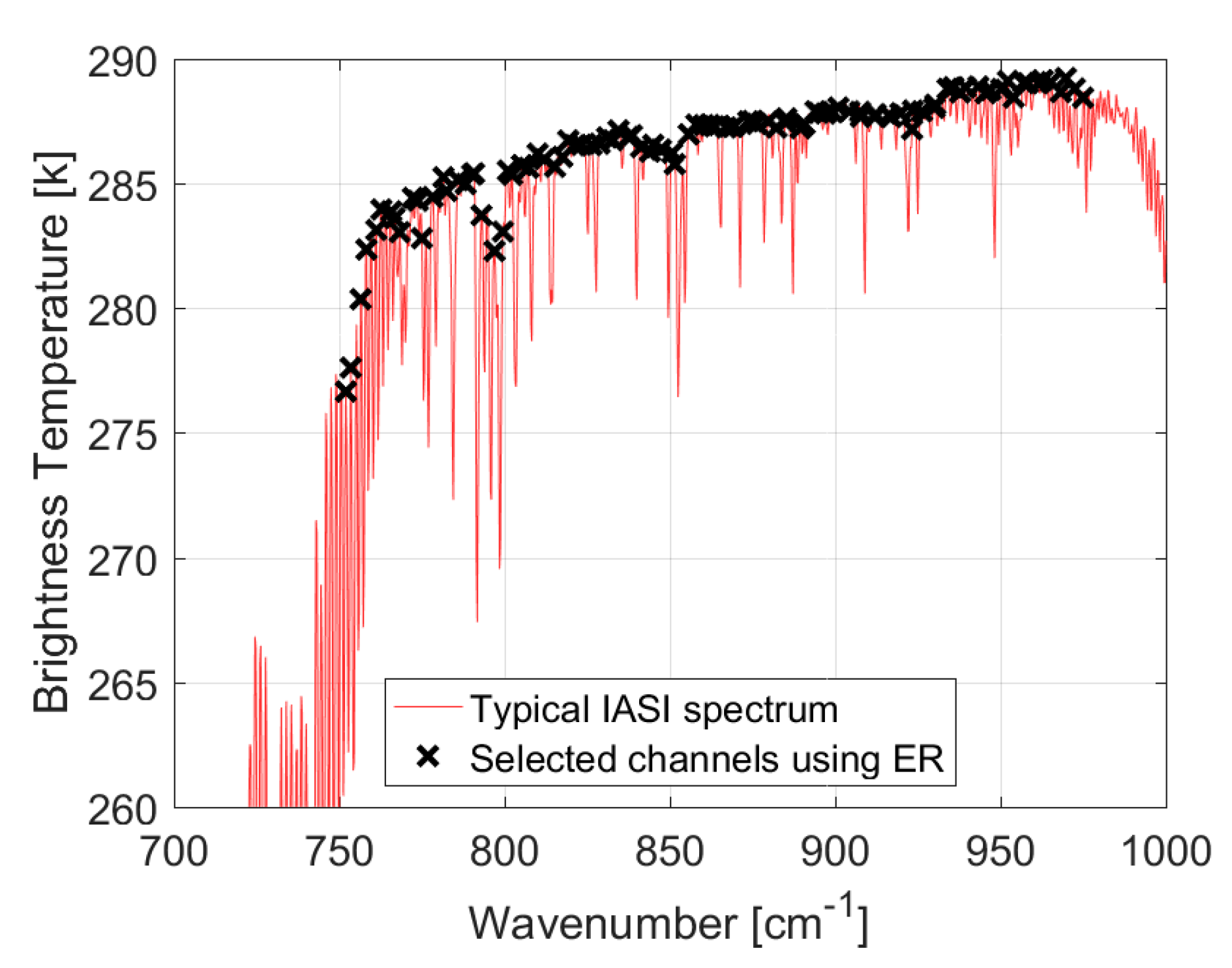
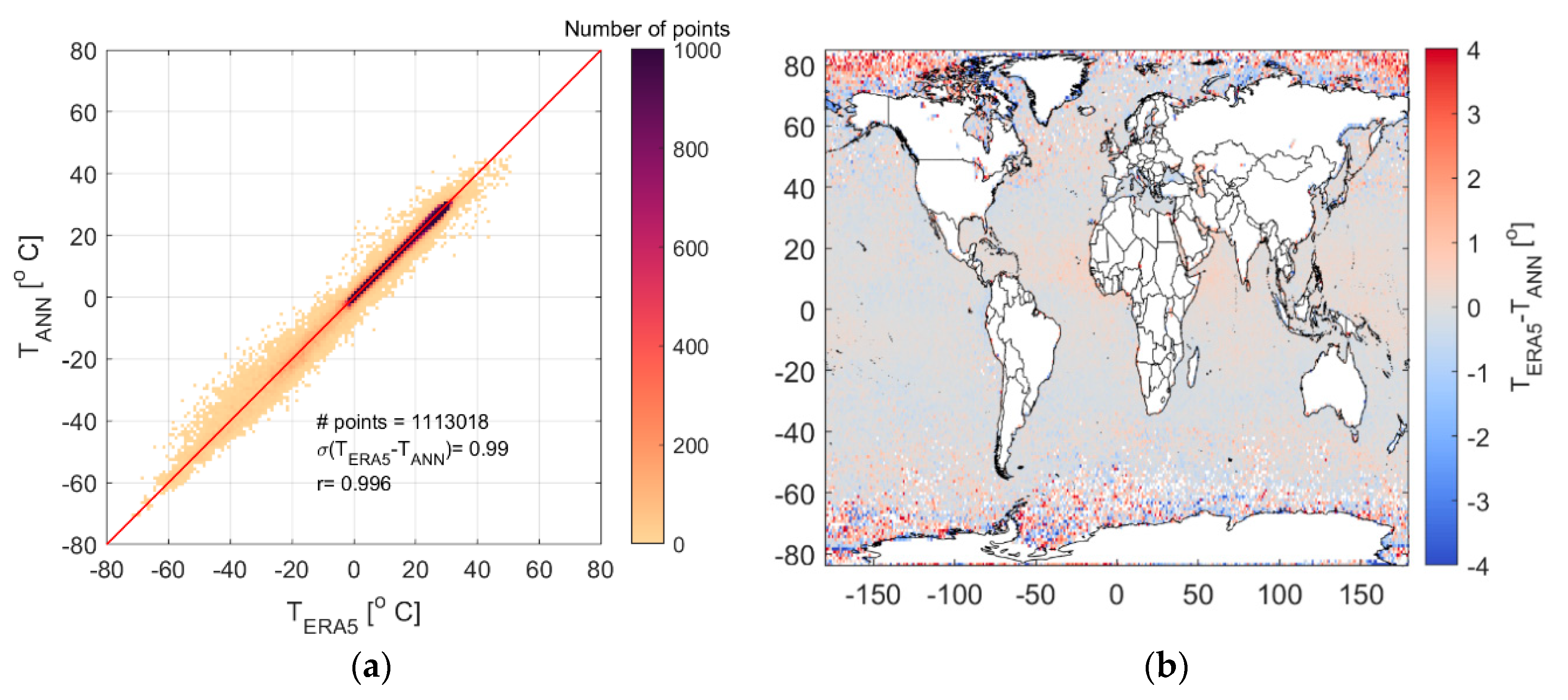

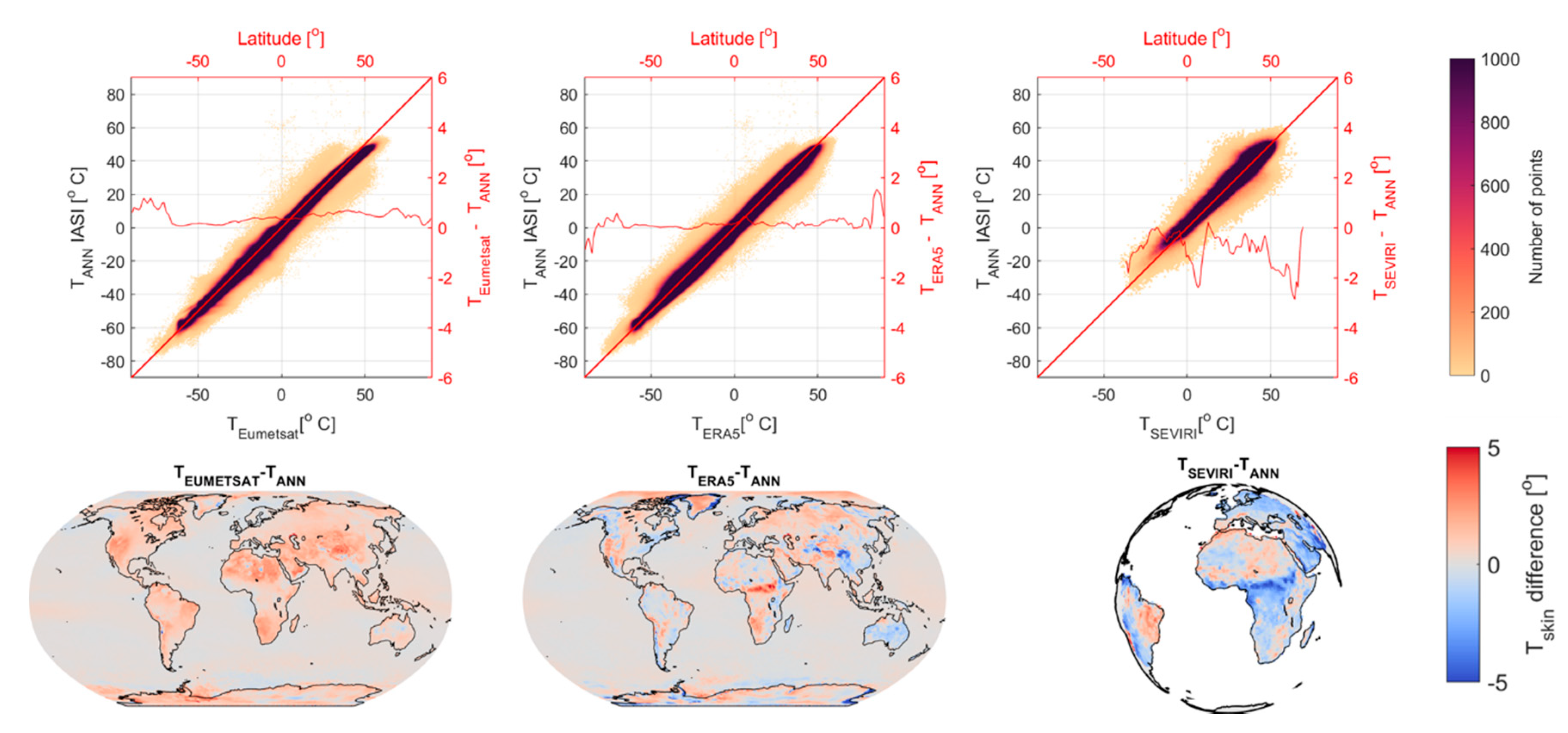
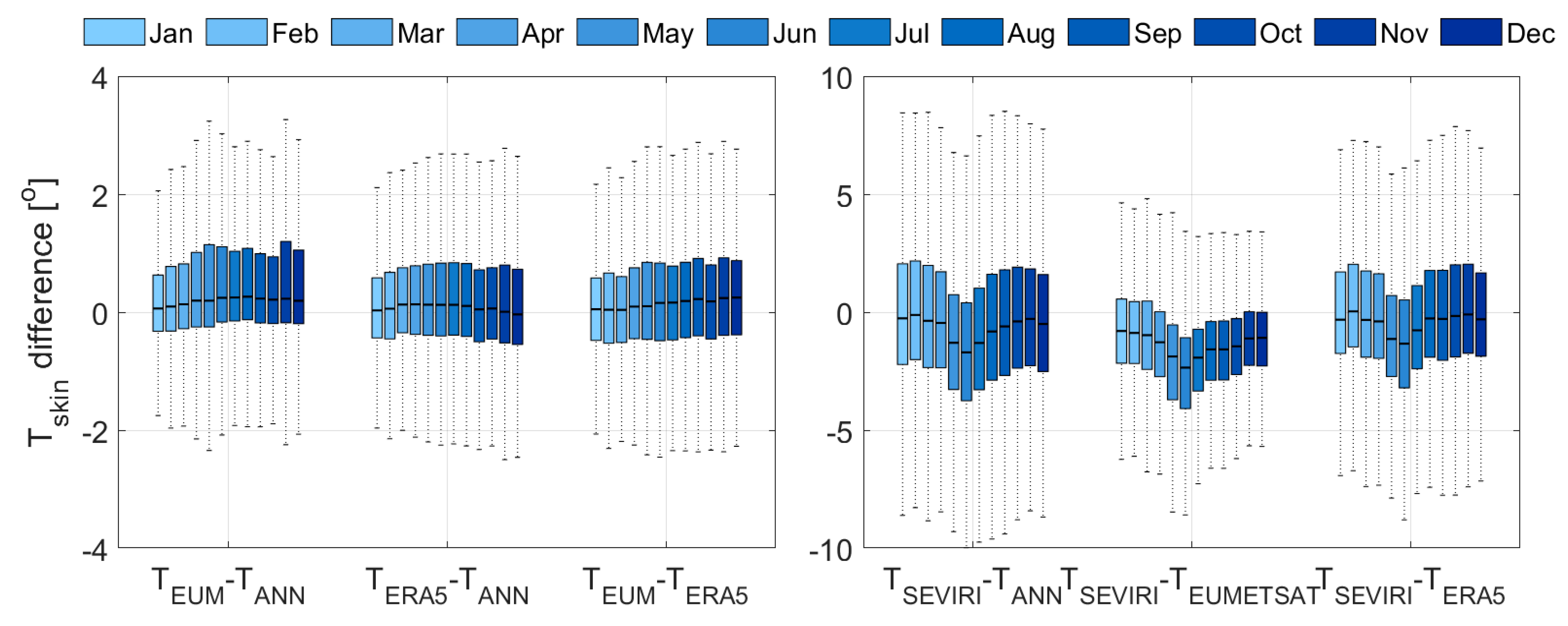
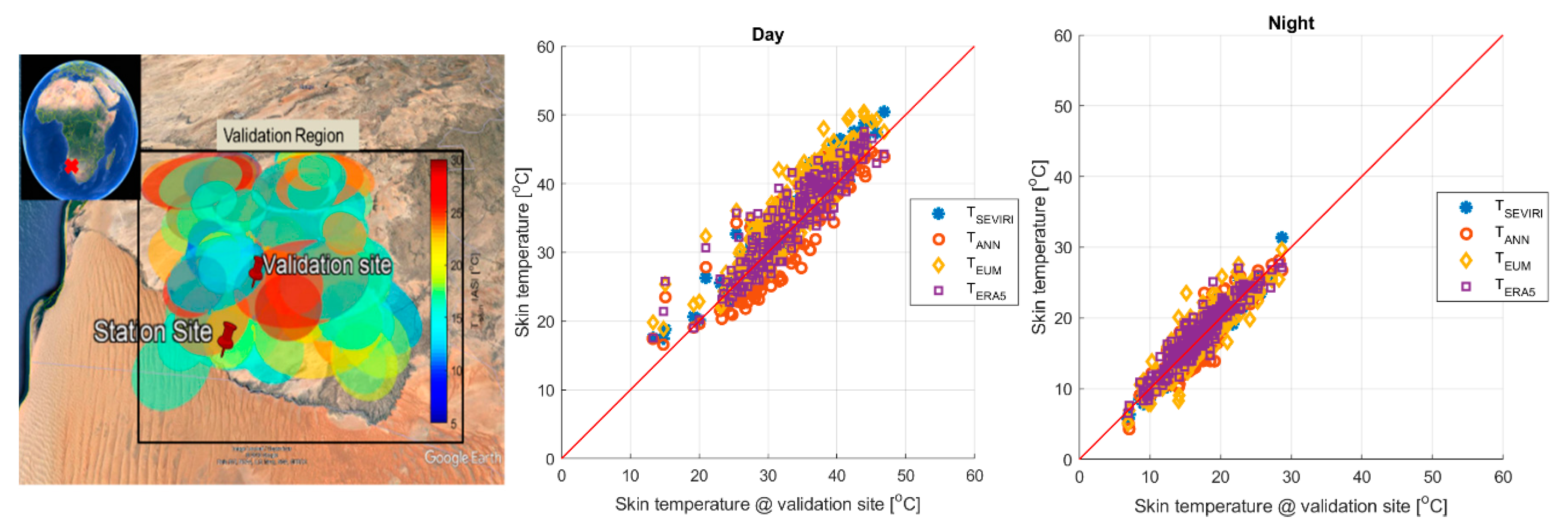
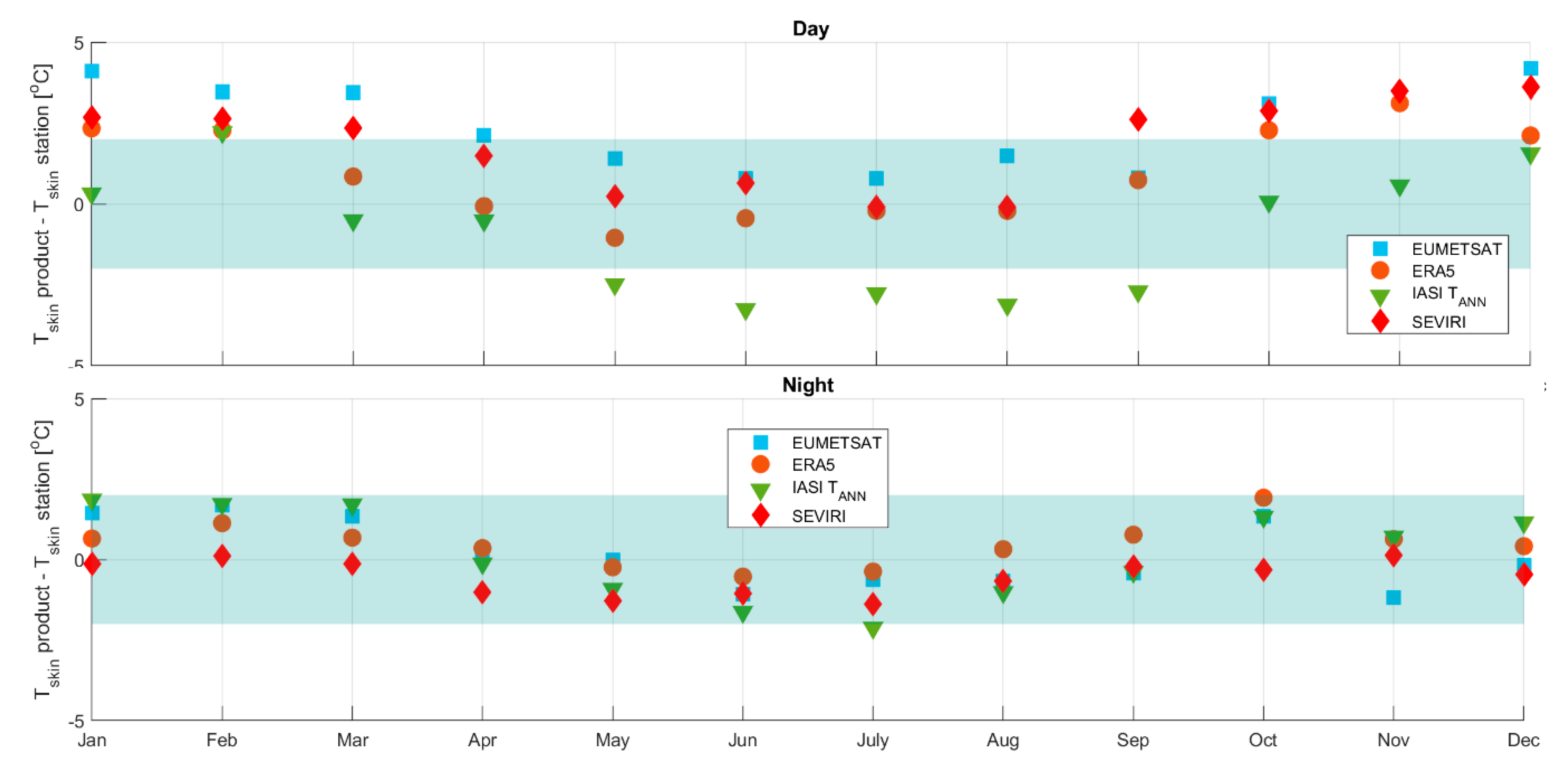
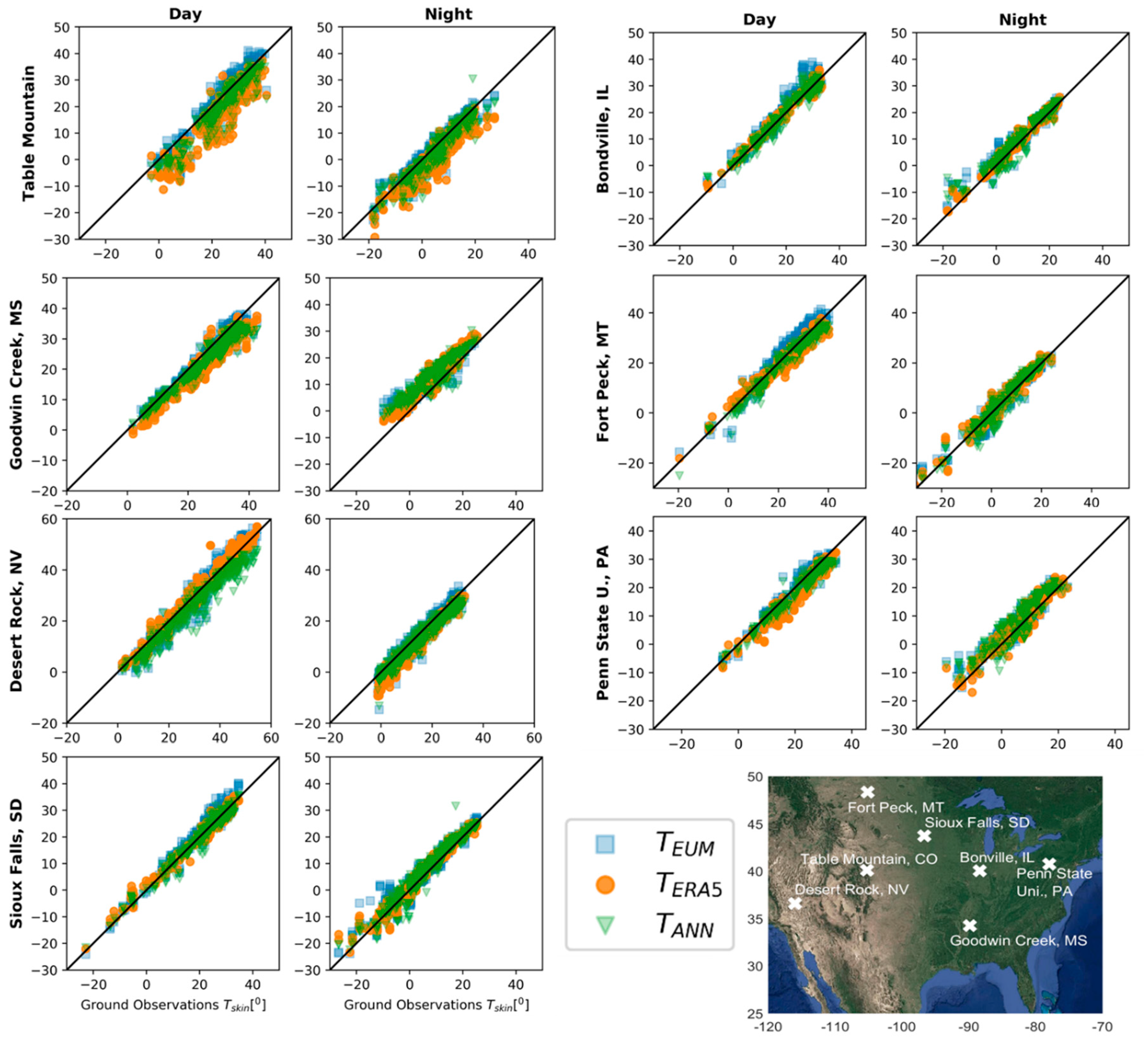
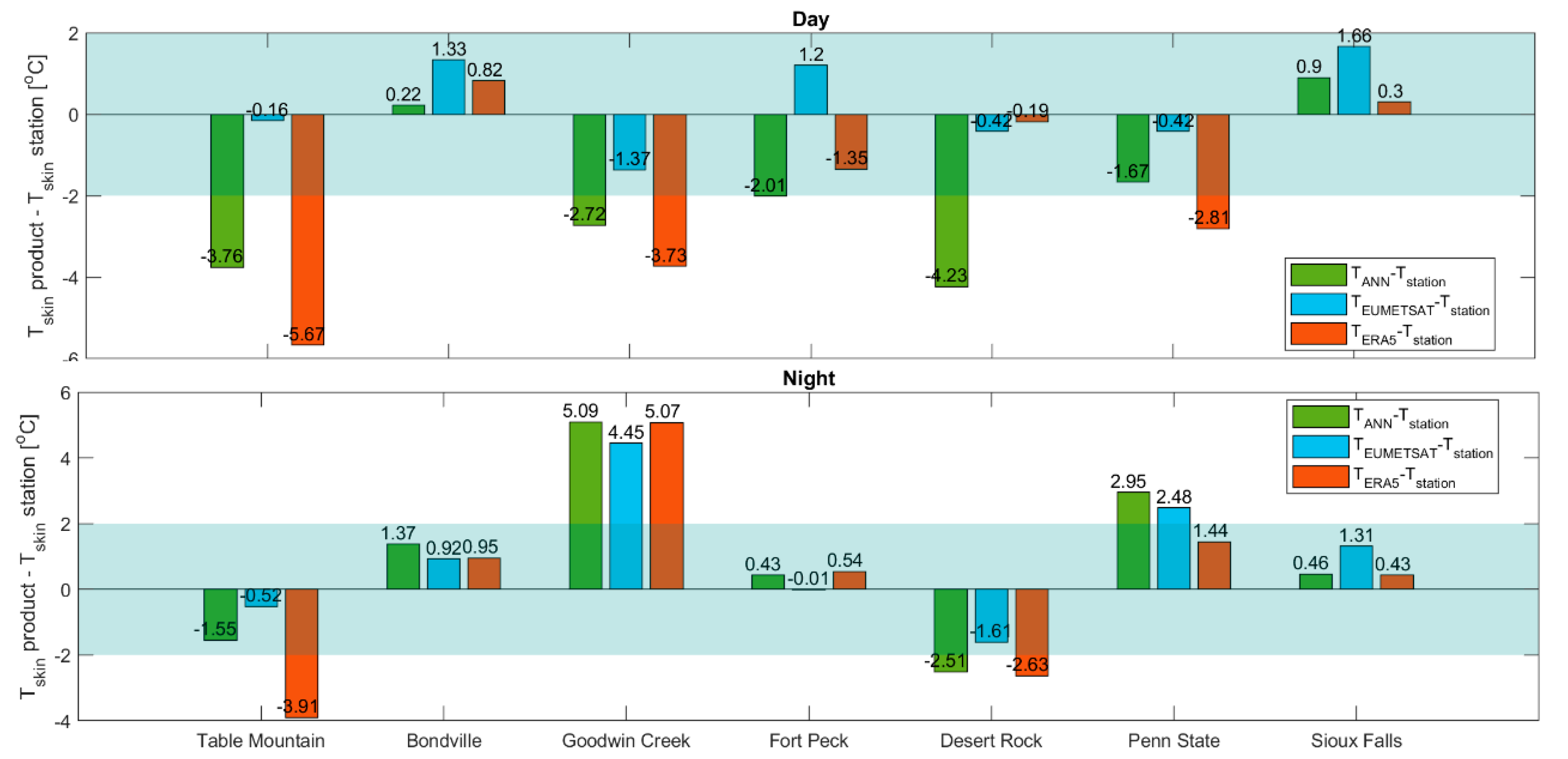
| Channel | Wavenumber (cm−1) | Channel | Wavenumber (cm−1) | Channel | Wavenumber (cm−1) | Channel | Wavenumber (cm−1) |
|---|---|---|---|---|---|---|---|
| 1300 | 969.75 | 1038 | 904.25 | 853 | 858.00 | 682 | 815.25 |
| 1282 | 965.25 | 1100 | 919.75 | 984 | 890.75 | 582 | 790.25 |
| 1249 | 957.00 | 1001 | 895.00 | 862 | 860.25 | 630 | 802.25 |
| 1272 | 962.75 | 1321 | 975.00 | 771 | 837.50 | 625 | 801.00 |
| 1254 | 958.25 | 1209 | 947.00 | 759 | 834.50 | 574 | 788.25 |
| 1294 | 968.25 | 1069 | 912.00 | 752 | 832.75 | 584 | 790.75 |
| 1230 | 952.25 | 997 | 894.00 | 797 | 844.00 | 547 | 781.50 |
| 1164 | 935.75 | 1070 | 912.25 | 745 | 831.00 | 551 | 782.50 |
| 1267 | 961.50 | 921 | 875.00 | 775 | 838.50 | 565 | 786.00 |
| 1194 | 943.25 | 962 | 885.25 | 801 | 845.00 | 516 | 773.75 |
| 1179 | 939.50 | 1051 | 907.50 | 714 | 823.25 | 510 | 772.25 |
| 1222 | 950.25 | 940 | 879.75 | 706 | 821.25 | 593 | 793.00 |
| 1311 | 972.50 | 916 | 873.75 | 698 | 819.25 | 534 | 778.25 |
| 1086 | 916.25 | 1114 | 923.25 | 844 | 855.75 | 484 | 765.75 |
| 1157 | 934.00 | 950 | 882.25 | 726 | 826.25 | 472 | 762.75 |
| 1172 | 937.75 | 869 | 862.00 | 810 | 847.25 | 488 | 766.75 |
| 1142 | 930.25 | 1237 | 954.00 | 736 | 828.75 | 494 | 768.25 |
| 1203 | 945.50 | 926 | 876.25 | 824 | 850.75 | 466 | 761.25 |
| 1018 | 899.25 | 961 | 885.00 | 691 | 817.50 | 619 | 799.50 |
| 1141 | 930.00 | 875 | 863.50 | 669 | 812.00 | 609 | 797.00 |
| 1009 | 897.00 | 979 | 889.50 | 661 | 810.00 | 521 | 775.00 |
| 1089 | 917.00 | 889 | 867.00 | 786 | 841.25 | 454 | 758.25 |
| 1115 | 923.50 | 899 | 869.50 | 827 | 851.50 | 447 | 756.50 |
| 1025 | 901.00 | 897 | 869.00 | 642 | 805.25 | 435 | 753.50 |
| 1126 | 926.25 | 1052 | 907.75 | 650 | 807.25 | 429 | 752.00 |
| Site Location | Latitude | Longitude | Surface Emissivity |
|---|---|---|---|
| Table Mountain, CO | 40.126° N | 105.238° W | 0.973 |
| Bondville, IL | 40.051° N | 88.373° W | 0.976 |
| Goodwin Creek, MS | 34.255° N | 89.873° W | 0.975 |
| Fort Peck, MT | 48.308° N | 105.102° W | 0.979 |
| Desert Rock, NV | 36.623° N | 116.020° W | 0.966 |
| Penn State U., PA | 40.720° N | 77.931° W | 0.972 |
| Sioux Falls, SD | 43.734° N | 96.623° W | 0.978 |
| Day | Night | |||
|---|---|---|---|---|
| Standard Deviation [°] | Accuracy [°] | Standard Deviation [°] | Accuracy [°] | |
| TANN–Tstation | 2.87 | −0.51 | 1.94 | 0.03 |
| TEUMETSAT–Tstation | 2.80 | 2.76 | 1.87 | −0.07 |
| TERA5–Tstation | 2.65 | 1.16 | 1.36 | 0.40 |
| TSEVIRI–Tstation | 1.88 | 2.25 | 1.04 | −0.56 |
| Day | Night | |||
|---|---|---|---|---|
| Standard Deviation (°) | Accuracy (°) | Standard Deviation (°) | Accuracy (°) | |
| TANN–TSURFRAD | 3.32 | −2.16 | 3.67 | 0.31 |
| TEUMETSAT–TSURFRAD | 3.20 | 0.15 | 3.20 | 0.59 |
| TERA5–TSURFRAD | 3.53 | −1.36 | 3.71 | −0.06 |
© 2020 by the authors. Licensee MDPI, Basel, Switzerland. This article is an open access article distributed under the terms and conditions of the Creative Commons Attribution (CC BY) license (http://creativecommons.org/licenses/by/4.0/).
Share and Cite
Safieddine, S.; Parracho, A.C.; George, M.; Aires, F.; Pellet, V.; Clarisse, L.; Whitburn, S.; Lezeaux, O.; Thépaut, J.-N.; Hersbach, H.; et al. Artificial Neural Networks to Retrieve Land and Sea Skin Temperature from IASI. Remote Sens. 2020, 12, 2777. https://doi.org/10.3390/rs12172777
Safieddine S, Parracho AC, George M, Aires F, Pellet V, Clarisse L, Whitburn S, Lezeaux O, Thépaut J-N, Hersbach H, et al. Artificial Neural Networks to Retrieve Land and Sea Skin Temperature from IASI. Remote Sensing. 2020; 12(17):2777. https://doi.org/10.3390/rs12172777
Chicago/Turabian StyleSafieddine, Sarah, Ana Claudia Parracho, Maya George, Filipe Aires, Victor Pellet, Lieven Clarisse, Simon Whitburn, Olivier Lezeaux, Jean-Noël Thépaut, Hans Hersbach, and et al. 2020. "Artificial Neural Networks to Retrieve Land and Sea Skin Temperature from IASI" Remote Sensing 12, no. 17: 2777. https://doi.org/10.3390/rs12172777
APA StyleSafieddine, S., Parracho, A. C., George, M., Aires, F., Pellet, V., Clarisse, L., Whitburn, S., Lezeaux, O., Thépaut, J.-N., Hersbach, H., Radnoti, G., Goettsche, F., Martin, M., Doutriaux-Boucher, M., Coppens, D., August, T., Zhou, D. K., & Clerbaux, C. (2020). Artificial Neural Networks to Retrieve Land and Sea Skin Temperature from IASI. Remote Sensing, 12(17), 2777. https://doi.org/10.3390/rs12172777






